NEC V801 Review: Benchmarking A Massive 80-Inch Monitor
Results: Brightness And Contrast
Uncalibrated
Before calibrating any panel, we measure zero and 100 percent signals at both ends of the brightness control range. This shows us how contrast is affected at the extremes of a monitor's luminance capability. We do not increase the contrast control past the clipping point. While doing this would increase a monitor’s light output, the brightest signal levels would not be visible, resulting in crushed highlight detail. Our numbers show the maximum light level possible with no clipping of the signal.
Our comparison group for this review is the last five displays reviewed here at Tom’s Hardware, plus a Pioneer PRO-111FD plasma HDTV. Pioneer no longer manufactures this screen, but it still represents the pinnacle of flat panel performance. All data is collected in the Pioneer’s ISF Day mode, which is a special picture preset accessed by software through the set’s RS-232 port.
Another note before we talk about the results: thanks to the V801’s separate backlight and brightness controls, we are able to control light output solely with the backlight slider. We're leaving brightness and contrast unchanged for all of the benchmarks.
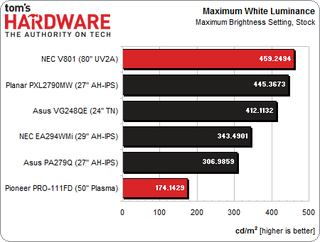
As a presentation product, the V801 needs to be as bright as possible, and it certainly delivers. While its output seems searing to us in our darkened testing space, it easily competes in a large room with skylights and other bright sources, such as what you'd see in a mall or building lobby. The Pioneer TV is actually quite bright...for a plasma, that is. Even the dimmest LCD monitors are brighter than most plasmas.
Here is where things get interesting.
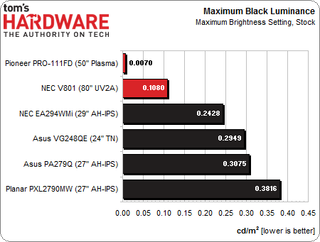
The PRO-111FD is the ninth and final generation of Pioneer’s Elite line of HDTVs. Its black levels are pretty much unmatched by any display of any type, even today. While the V801 delivers a superb result and handily beats even the Samsung S27B970D for maximum black level, it isn’t anywhere near the reference-level plasma. However, for such a bright display, the V801 turns in incredible performance.
Here’s the final contrast result.
Stay on the Cutting Edge
Join the experts who read Tom's Hardware for the inside track on enthusiast PC tech news — and have for over 25 years. We'll send breaking news and in-depth reviews of CPUs, GPUs, AI, maker hardware and more straight to your inbox.
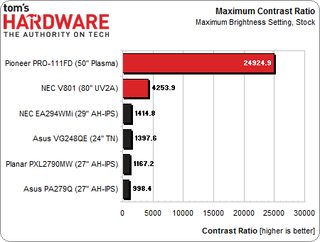
While we’re impressed with any contrast ratio over 1000:1, the V801 and PRO-111FD take that metric to an entirely different level. Even at the brightest setting, the images on these screens truly look 3D. We firmly believe that dynamic range is the most important factor in image quality. For a more thorough explanation of that concept, please read Display Calibration 201: The Science Behind Tuning Your Monitor.
We had to do things a little differently for the minimum luminance tests. On the V801, we left the brightness control alone and turned down the backlight control instead. Reducing brightness below a setting of 51 crushes shadow detail, but lowering the backlight slider does not. To turn down light output on the Pioneer, we set its contrast control to zero.

The Pioneer still presents a usable image, but NEC doesn't. We also took measurements at an output level of 53.3502 cd/m2 to get more realistic black level and contrast numbers.
Here are the black level measurements.
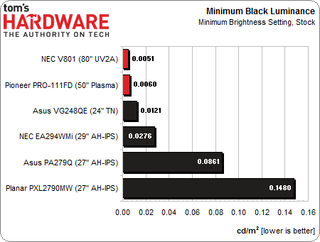
At the minimum brightness setting, NEC beats the Pioneer by a scant .0009 cd/m2. When the white level is raised to 53.3502 cd/m2, the black level is a still-excellent .013 cd/m2.
We’ll wrap up this section with the minimum contrast comparison.
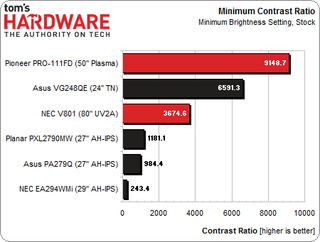
NEC's panel achieves an impressive contrast result. Of course, the Pioneer is in another universe altogether. Even more impressive: when we measure the V801’s contrast at 53.3502 cd/m2, it climbs higher to 4091:1.
After Calibration
Since we consider 200 cd/m2 to be an ideal point for peak output, we calibrate all of our test monitors to that value. In a room with some ambient light (like an office), this brightness level provides a sharp, punchy image with maximum detail and minimum eye fatigue. It's also the sweet spot for gamma and grayscale tracking, which we'll look at on the next page.
As you saw in the max white test, the PRO-111FD can’t quite reach 200 cd/m2, so we took a second set of calibrated luminance measurements from the V801 at 171.3207 cd/m2. This is a more palatable light level for watching an HDTV in a darkened room.
We start with the calibrated black level. This can sometimes rise a bit from the monitor’s default state. We consider the tradeoff in contrast well worth the gain in color accuracy.
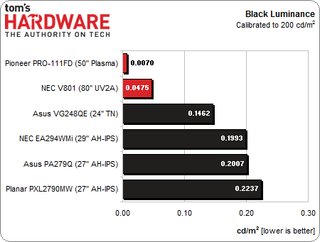
The V801 is our new calibrated black level champ among LCDs. Pioneer's television is renowned for its black levels. How does this translate to reality? When the PRO-111FD is displaying a zero-percent signal, you can’t tell it’s turned on. The NEC’s black level of .0475 cd/m2 is incredibly low, but still visible to the eye.
Here are the final calibrated contrast numbers.

The V801 has almost three times the contrast ratio of the next best performing LCD in our tests, ViewSonic's VX2770Smh. The image depth on this screen is really something to see, and that’s why it makes such a good HDTV.
ANSI Contrast Ratio
ANSI is another important indicator of contrast. We measure a checkerboard pattern of sixteen zero and 100 percent squares, which is somewhat more real-world than on/off measurements because it tests a display’s ability to simultaneously maintain both low black and full white levels, and factors in screen uniformity. The average of the eight full-white measurements is divided by the average of the eight full-black measurements to arrive at the ANSI result.
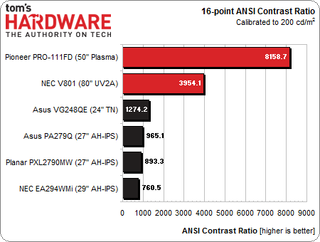
Why is the Pioneer’s ANSI number so much lower than its on/off one? Because of the power supply limitations inherent in this display type. It takes a lot of current to drive a large plasma panel, so less juice is available when the overall picture brightness increases. You might measure a 100 percent window pattern at 170 cd/m2. But measure a 100 percent full field pattern and the result will be more like 46 cd/m2, a brightness drop of over 75 percent. LCDs do not have this issue, so the V801’s ANSI value is only slightly lower than its on/off number.
Current page: Results: Brightness And Contrast
Prev Page Measurement And Calibration Methodology: How We Test Next Page Results: Grayscale Tracking And Gamma Response
Christian Eberle is a Contributing Editor for Tom's Hardware US. He's a veteran reviewer of A/V equipment, specializing in monitors. Christian began his obsession with tech when he built his first PC in 1991, a 286 running DOS 3.0 at a blazing 12MHz. In 2006, he undertook training from the Imaging Science Foundation in video calibration and testing and thus started a passion for precise imaging that persists to this day. He is also a professional musician with a degree from the New England Conservatory as a classical bassoonist which he used to good effect as a performer with the West Point Army Band from 1987 to 2013. He enjoys watching movies and listening to high-end audio in his custom-built home theater and can be seen riding trails near his home on a race-ready ICE VTX recumbent trike. Christian enjoys the endless summer in Florida where he lives with his wife and Chihuahua and plays with orchestras around the state.
-
Someone Somewhere Yeah, 1920x1080... those pixels are 0.92mm square. That's pretty easy to see with the naked eye; far bigger than a full stop.Reply
27.5ppi... *shudders*.
EDIT:
the V801’s size is better expressed in feet: 227.6 (69.37 square meters for the rest of the world)
Ummm... 70 square meters is pretty big. That's about half of the average house. I think you'll find it's ~1.76 m² or 19 ft². -
virtualban For that size I clicked the article in hopes that maybe it was some 8K monitor. Stopped reading after 1080pReply -
baddad I've had a Mits 82" DLP since 2011 I paid $1900.00, that is the heart of my media center, so $9400 for just a monitor is a bit much.Reply
Most Popular

